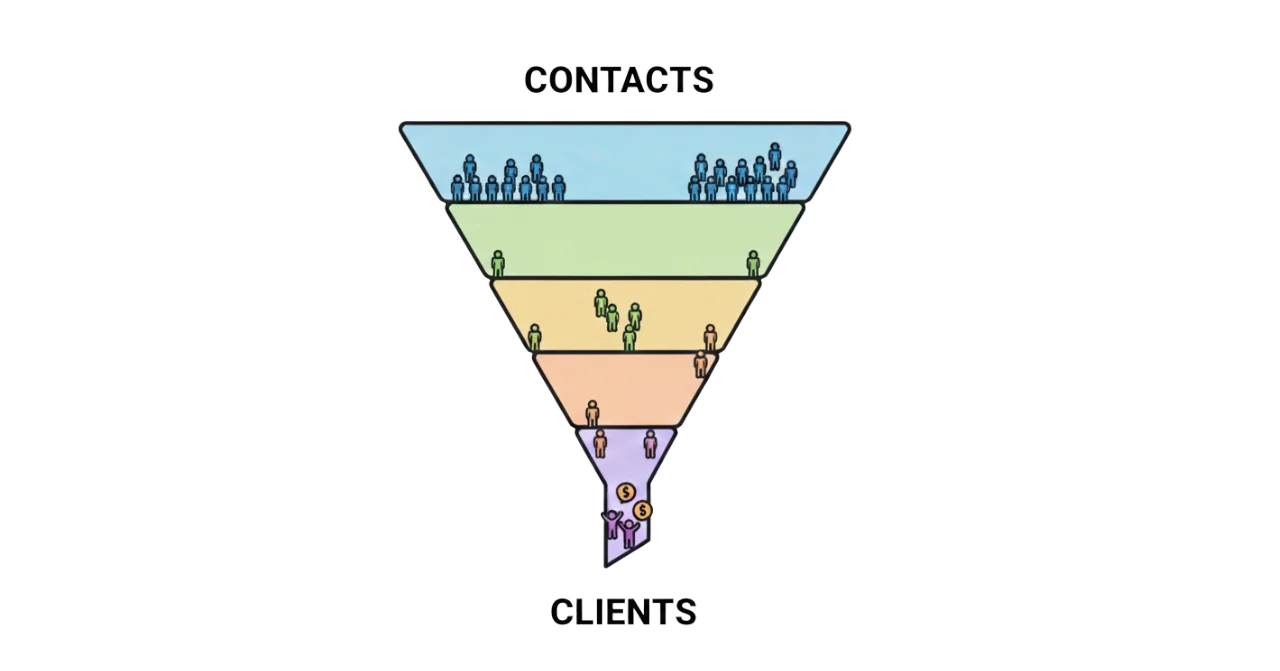
Your First Sales Process: A Step-by-Step Guide for Non-Salespeople
A step-by-step starter guide for non‑salespeople
If your “sales process” lives in inboxes, spreadsheets, and memory… no wonder follow-ups get missed and deals stall.
- Spreadsheets can’t ping you with reminders.
- Notes in random files disappear when someone’s off sick.
- Forecasts become “gut feeling” instead of facts.
You don’t need to be a sales guru to fix this. You just need a simple, repeatable process — and ideally a system that keeps you consistent.
Here’s the side‑by‑side version: spreadsheet hacks vs. MiniCRM.
Step 1: Define your stages (4–6 is enough)
Think of your pipeline as a few clear steps:
New Lead → Qualified → Proposal → Committed → Won/Lost
Exit criteria = what qualifies moving forward. Do [Activity] + Confirm [Info].
Example: Move to “Qualified” only once you’ve had a call AND confirmed budget + timeline.
Common failure: Too many stages = confusion. No “next step” = forgotten deals.
In a spreadsheet
Add a Stage dropdown. Add columns for “Next Step” + “Due Date.” Use conditional formatting to highlight overdue. ➜ Works… but only if you remember to check the sheet every day.
In MiniCRM
Customize stages to match your process. Log “Next Step” tasks directly on deals with auto reminders. Reports show totals by stage so you instantly see what’s healthy & what’s stuck.
Step 2: Standardize data + ownership
Keep only the must-haves: Company, Contact, Email, Phone, Owner, Source, Value, Last Activity, Next Step.
Rule: Every deal has an owner. “Unowned” = forgotten.
Common failure: Duplicates + ambiguity about “who owns what.”
In a spreadsheet
One workbook with Contacts + Activity/Tasks. Assign each lead to someone. Check progress daily/weekly. Fragile: prone to version chaos + copy‑paste errors.
In MiniCRM
One central record for contacts, deals, emails & invoices. No unassigned leads. Decide who gets leads from different sources. Use filtered lists + “Today view” + reports for efficient weekly check-ins.
Step 3: Capture every lead at the source
Leads come from website forms, email, phone calls, events… scatter them and you’ll lose some.
In a spreadsheet
Connect a Google Form to reduce manual entry. Downside: calls + email threads stay outside → poor context.
In MiniCRM
Web Forms put leads straight in the pipeline. Gmail/Outlook sync continues conversations. Calendar + mobile app = capture info on the go. ➜ Context follows the customer, not inboxes.
Step 4: Set a follow‑up rhythm
Deals don’t die from rejection, they die from silence. Simple cadence:
- Day 0 = respond
- Day 2 = check in
- Day 7 = follow up
- Day 14 = final attempt
Always log a future step.
Common failure: Relying on memory — you won’t.
In a spreadsheet
Track tasks in a Tasks tab (Status + Due Date). Filter for overdue + next 7 days. Still manual — requires habit of daily review.
In MiniCRM
Tasks + reminders are automatic. Daily “Today View” shows what’s due. Alerts prevent slips. Emails/notes log automatically → no context loss.
Step 5: Weekly pipeline review
Spend 20 minutes weekly checking:
- New leads this week
- Stuck deals
- Forecast of what’s about to close
- Every deal has a next step + owner
In a spreadsheet
Quick pivot by stage + owner. Snapshot ok but weak forecasting.
In MiniCRM
Built‑in reports = stage conversion, pipeline size, forecasts. Closed→Invoice in clicks, plus project/kanban tools smooth the handover.
The Daily 15‑Minute Rhythm
- Triage Today: clear overdue + due tasks
- Log every call/email/meeting
- Scan for cracks: “No Next Step” → fix immediately
Do this and you’ll never lose track of a deal again.
Your 60‑Minute Quick Start with MiniCRM
- Define 4–6 stages (with exit rules)
- Clean spreadsheet + remove duplicates
- Create MiniCRM account → import deals → assign owners
- Add a website form + test lead
- Save 3 views: Overdue, New Leads, Closing Soon
Done — you’ve got a working sales process on day one!